Introduction
Many people shy away from a Street Prepared class build because they are "expensive" and "unreliable" and while it's true that you can toss a pretty penny into a BSP build, it doesn't really have to be this way. I've certainly spent more than I care to sum up and disclose in Bumblestook but knowing what I know now and comparing it to the similarities in my STR class build of Lupa (my other S2000), I thought I'd take a crack at putting together a list of things you'd need to do to make a fairly competitive budget BSP S2000. I'd say this kind of build is probably 90% of the way to a full BSP build and is a good way to have lots of the BSP fun at just a small cost above a fully prepped STR build. |
| Bumblestook - Fully Prepped SCCA B-Street Prepared S2000 |
Chassis Selection
You have two ways to go here. You can either go with an AP1 (2000-2003) or AP2V1 (2004-2005) S2000. As I go on you'll see why I'm proposing going this route but mostly this is to keep costs down. In stock trim, the AP1 comes with a 2.0L engine (F20C) that revs to 9000rpms and has taller gearing, whereas the AP2 comes with a 2.2L engine (F22C) that revs to 8200rpm. The AP1 is regarded as being much more twitchy due to a rear suspension geometry that creates dynamic toe out under compression. This is generally considered a negative characteristic but Bumblestook is an AP1 (2002) and I've tuned my setup to take advantage of this weakness so personally I think either chassis will do fine provided you set up for it.The AP1 also has the advantage of having the faster steering rack similar in ratio to what you find the S2000 CR. Both the AP1 and AP2V1 have fully mechanical throttle bodies and the drive trains are interchangeable between the two generations making it suitable for taking advantage of the Street Prepared update/backdate rules. AP2s also have a bit of reinforcement in the front upper control arms adding to their reliability. If you want to keep costs really down, try to find one with a salvage title that wasn't actually in an accident. Many S2000s get their soft tops cut open when thieves steal their seats and many car insurance companies total S2000s as a result of this relatively "minor" damage. The other reason you might want a salvage titled car aside from being cheaper is because you're going to be cutting and pulling fenders to fit some fat wheels/tires anyway.
Prices:
$8000-$15000 (depending on chassis and condition)
Engine/Transmission Swap
This is where it gets interesting. No matter what chassis you choose, you want an AP2 engine (F22C) and an AP1 transmission. This is because the greater displacement of the F22C produces better midrange torque than the F20C but doesn't rev as high so the taller gearing of an AP1 transmission helps increase the top speed at 2nd gear. After a tune and bumping the rev limiter up to the 8600-8800 range, you'll be able to achieve a top speed of around 66-68 mph in 2nd gear which is very useful for some of the higher speed national level courses.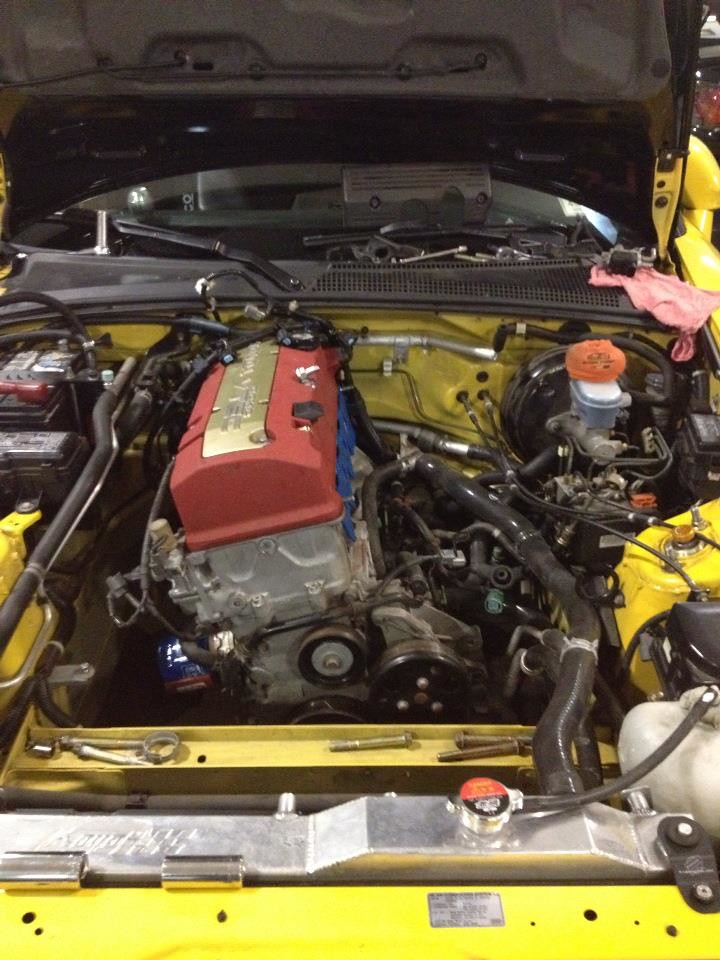 |
| F22C in AP1 chassis (minus the intake manifold) |
I'd also personally recommend getting upgraded motor and transmission mounts that use 75A polyurethane bushings. I use the Innovative 75a mount kit on Bumblestook. Also, depending on your budget, if you're already going to swap the transmission or engine, now would be a good time to change the clutch if it's due for replacement. If you replace the clutch, I highly recommend an AP1 flywheel, OEM clutch with ACT HD pressure plate. It provides a very reliable setup with great pedal feel that can handle quite a bit more power and if you started off with an AP2, a significantly lighter flywheel (14lbs vs 22lbs).
Prices:
Used AP1 transmission (If starting with AP2) - $350-600
Used F22C (If starting with AP1) - $2500
Used AP1 steering rack (If starting with AP2) - $200
Innovative 75A motor/transmission mounts - $350
Clutch, flywheel and pressure plate (Optional if due for replacement anyway) - Around $800-$1000
Differential
The stock Torsen differential is great but personally I find that a 1.5 way clutch type LSD works a bit more predictably and is better for a Street Prepared application. As a bare minimum you could just put in a 1.5 way LSD (I use the ATS Spec III, others use OSGiken, your choice really) into the existing diff housing on the car. The differential is where most S2000s have had failures so instead, I'd recommend getting a used diff housing and putting the 1.5 way LSD in that and swapping the entire pumpkin so you have a spare. One important consideration here is that the flange going to the diff and the flange on the output shaft of the transmission (well driveshaft really) is different on an AP1 and AP2.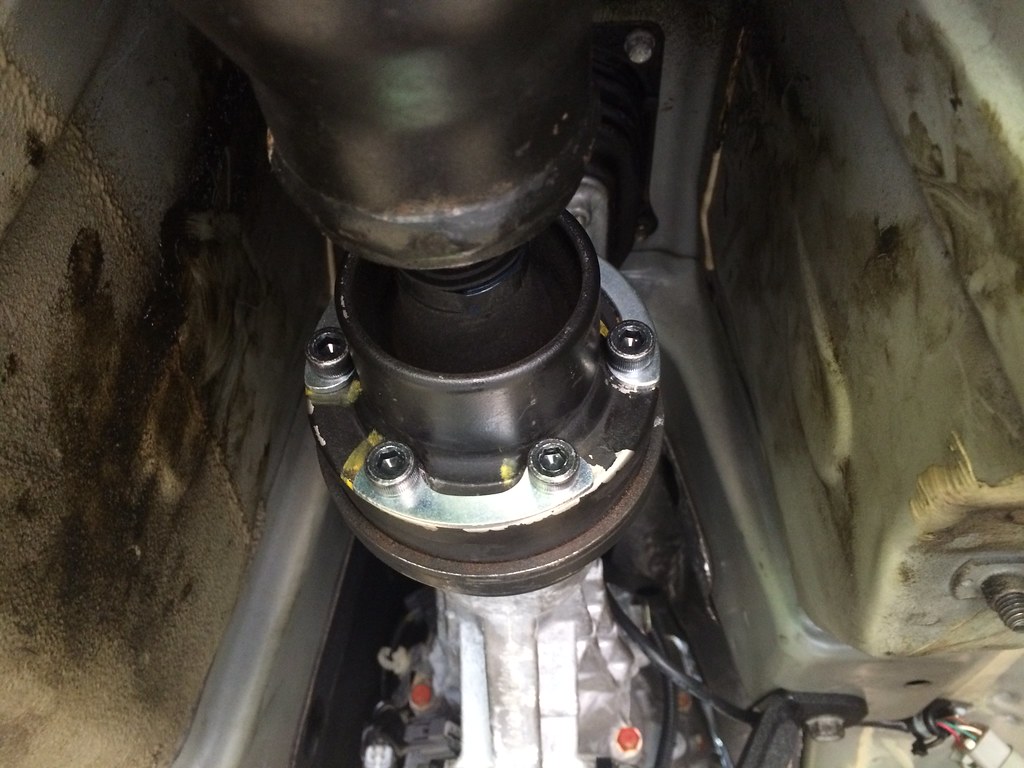 |
| AP1 Transmisson to AP2 differential using 8mm AP1 bolts |
Prices:
1.5 way LSD - $1800
1.5 way LSD with used diff housing and seals (recommended) - $2500
Power Mods
A full BSP S2000 build will use some kind of larger intake manifold and throttle body to get maximum power but the F22C is already so well tuned from the factory that this extra cost really only nets you about an additional 10 hp and 10 ft-lb of torque across the entire power band (assuming 93 octane pump gas here). This is nice to have but I think it's not an absolute must so the standard STR class power mods are all you need here. Add a K&N FIPK instake for better breathing. Get a header both to save weight and to make power. The cheapest good option here is the PLM header which is really a clone of the J's racing manifold. |
| PLM header (top), stock (below) |
Prices:
K&N FIPK - $300
PLM Header - $350
70mm Test Pipe - $70
70mm Single Side exhaust - $800
AEM or Haltech ECU - $1300-$1400
Tune - $600
Suspension
Similar to a STR build, I'd recommend getting some kind of dual adjustable reputable shocks from Moton, MCS, Penske or JRZ and pair it with some fairly stiff springs. I run 1000lb front and 900lb rear springs on Bumblestook. Depending on your car setup, you may want to opt for a different spring combination. Add front and rear sway bars. I highly recommend the Karcepts front and rear sway bars. You'll want to add something to add more front camber. Similar to many STR setups, you can run a Hardrace offset camber joint (don't get the roll center adjusting ones, just the offset one).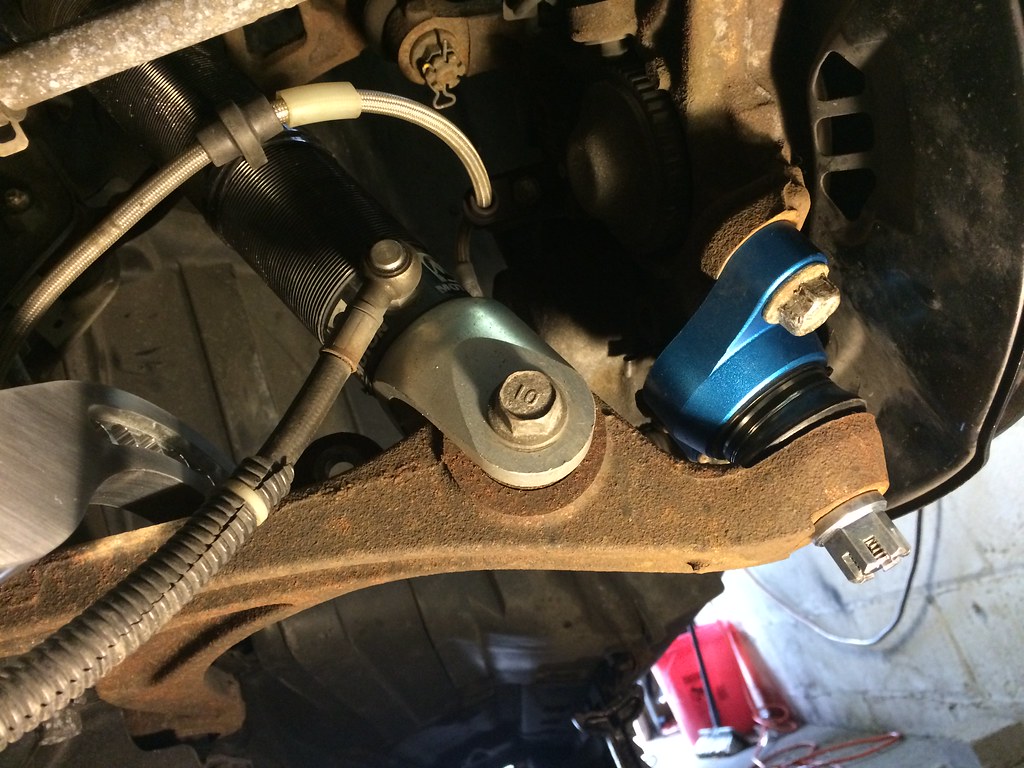 |
| Hardrace offset camber ball joint (blue) |
Prices:
Shocks and springs - $2500-$3000
Karcepts front and rear sway bars - $1000
Hardrace Camber Joint - $300
Mugen hard rubber front compliance bushings - $100
Wheels/Tires
Wheels and tires are unlimited in Street Prepared. Tire choice is easy, Hoosier A7, no question. For the rear you'll want to run a 315/30/18 and for the front, you'll want either a 285/30/18, 295/30/18 or 315/30/18. Obviously wheel size will vary depending on what tire you end up choosing. I run 18x11 front and 18x12 rear. The reality is that there aren't really any out of box wheel options out there for such a wide wheel on a S2000 since we run such high offsets so you're going to have to go custom. I use CCW, others have had good success with Forgeline (not to be confused with Forgestar!).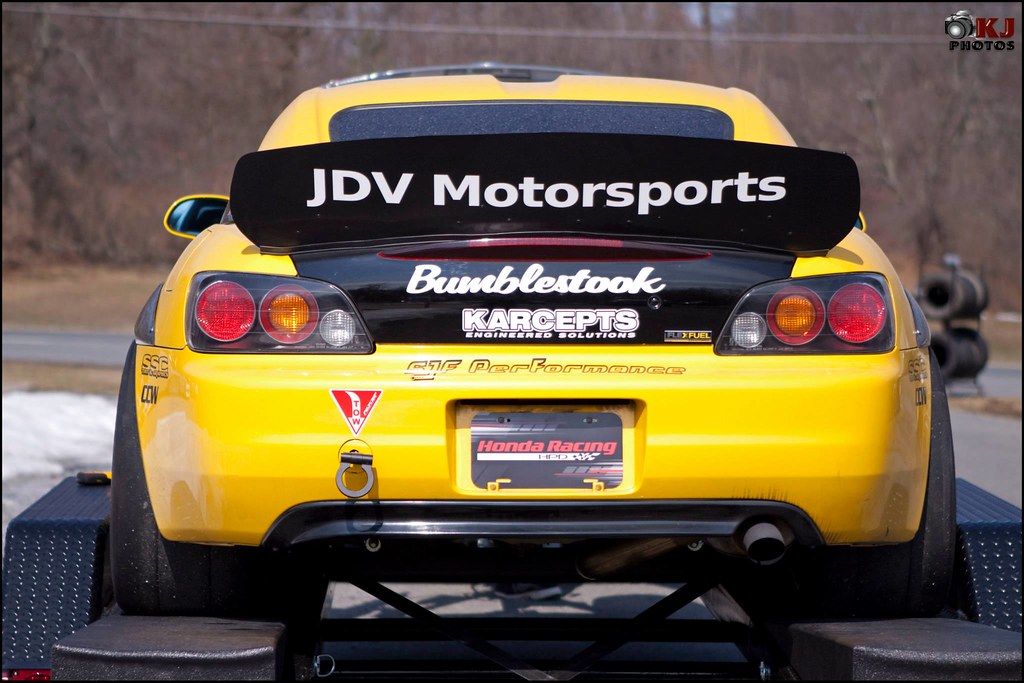 |
| Fatty wheels/tires |
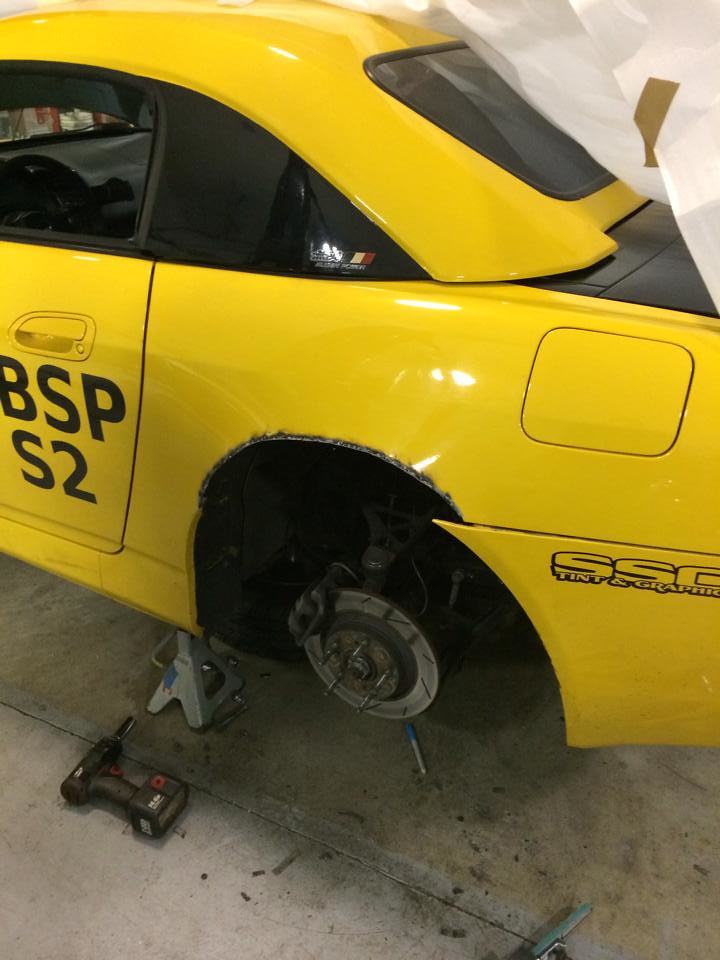 |
| Rear quarter panels cut |
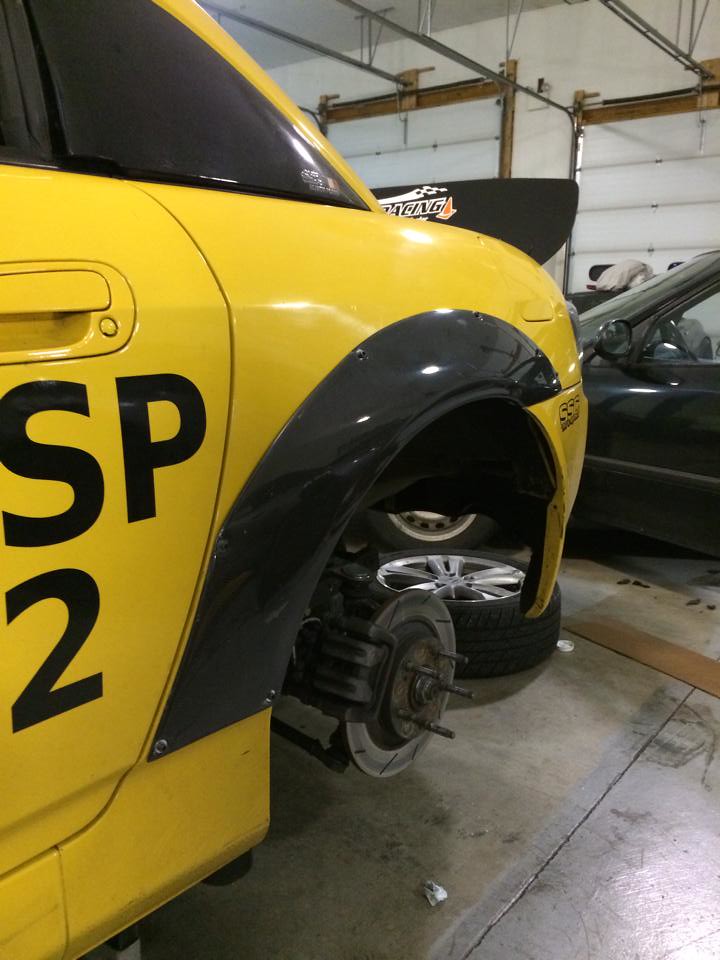 |
| Overfenders bolted on |
Wheels - $2000-$3000
Tires - $1500-$1600 (your first set)
Shine rear over fenders - $200 (FRP), $275 (Carbon fiber)
Brakes
Stock brakes are fine but I'd swap out the brake compound with something a bit more aggressive since you've got so much more grip now. I use Hawk HP+ pads. Optionally while you're at it, go put in some stainless braided lines for performance and safety.Prices:
Hawk HP+ brake pads: $120
Stainless braided lines $100
Interior
You really don't need to do anything here but I'd recommend replacing at least the driver seat with a full on bucket racing seat and rails. BSP cars on Hoosiers generate lots of lateral grip and change directions like nobody's business so you'll want something to keep you in place. I use Recaro Pole Position seats with Ballade Sports rails. You can certainly find cheaper seats and rails. Find whatever works for you.Prices:
Bucket Seat: $300-800
Rails: $100-300
Conclusion
First off, all the prices I've listed above are rough estimates. Unless I mention otherwise they are for new parts so money can be saved by buying used where appropriate. Also, with the engine or transmission swap, if you start off with a good engine and transmission you can also sell the old engine or transmission to recoup some of the cost after you do the swap. I'm also not factoring any labor costs in any of these. If you're not mechanically skilled enough to do these yourself you will have to factor in costs of paying someone else to do it (or have really good friends that will help you do it).More importantly, I wanted to note that almost everything I've listed above is something you'd do to prep a STR S2000. The major differences are the transmission and steering rack swap (assuming AP2 starting point), cutting/pulling fenders, and adding wide wheels and tires. Once you've committed to widening the car, I'd say with the stuff I've listed above, a budget BSP S2000 build is only about $5000 more than a STR build. However, if you have a pristine S2000 in STR trim, I bet you could sell that STR S2000 for good money, buy a less perfect chassis S2000 and build the budget BSP S2000 for the same price.
Frequently Asked Questions
How much more would I have to do to be a fully prepped BSP S2000 after doing this?
- Lightweight battery
- Lightweight brakes
- Remove the AC and radio
- Remove the soft top and replace with a CR Tonneau cover to save weight
- Change the passenger seat to save a bit more weight
- Switch to a larger intake manifold and throttle body, add higher flowing injectors and fuel pump and retune to add about 10 hp and 10ft-lb of torque across the entire power band
- You can also tune the car for E85 and make an additional 10hp and 10ft-lb of torque on top of the gains of a bigger intake manifold and throttle body
- Add a front and rear spoiler
As you can see you're not really adding a ton of additional power so the return for the power mod investment is rather small so a lot of the mods are more for reducing weight.
You say you don't need all this stuff but you've got tons of stuff on Bumblestook, why?
To be honest, the answer is just "because I can". Mostly it was because at the time I moved to BSP, there were less than a handful of us building for this class and there wasn't a lot of data so lots of money was spent on trial and error and R&D. For the most part, very few things actually made a difference but I had already spent the money so the mods are staying on the car. If I had known then what I know now, I could've easily saved a significant amount of time and money.
STR is so much fun, why would I bother moving to BSP?
As a S2000 owner, most of my S2000 racing buddies run in STR. It's popular with lots of competitors and is certainly a lot of fun. It's so much fun that my 2nd S2000 is prepped for STR. That being said, the main draw for STR is the sheer number of competitors and while I have fun driving a STR S2000, nothing is even remotely comparable to driving a BSP S2000. I race for the competition but this is a serious hobby I do because it's pure fun and Bumblestook in BSP trim gives me more "smiles per second" than anything else I care to drive. Once you've driven a BSP S2000, you simply can't go back. Watching people's disbelief in the ridiculous times you can set in one of these just takes fun and enjoyment to a whole new level.
BSP S2000s break more easily than STR S2000s though. I'm afraid of that!
I'm going into year 4 of campaigning Bumblestook nationally. In those years I've only actually broken one thing, the differential. The other "failures" I've had were mechanical issues where bolts weren't tightened down properly. My STR friends have had similar failures so I don't really think that's a valid argument. Things can break when you go racing. BSP S2000s don't brake anymore than STR ones do.
Ok so I can maybe build a BSP S2000 for the price of a super clean STR S2000 and maybe I won't break any more frequently than STR, it's still more expensive because Hoosiers don't last long
Hoosier has vastly improved the longetivity of their tires. On good surfaces, you're able to get almost as many decently competitive runs out of A7s as you are from the top tier competition street tires. At the end of 2015, to "kill" my old 140 run tires, I had 4 drivers take my car out for almost 10 runs each and we were still able to set FTD (http://bumblestook.blogspot.com/2015/10/ending-season-on-high-note.html) and the tires still have life in them if I wanted to use them for local events today. Also, while we really don't have a "spec tire", almost everyone in street prepared runs Hoosiers making tire selection easy. The street tire guys are constantly testing and trying different new street tire compounds. Many of my STR friends have more sets of wheels and tires than I do for my BSP car.
Are S2000s even competitive in BSP?
Since the S2000 was added to BSP in 2012, a S2000 has won the national championship 3 of the 4 years so far. I'd say it can be capable especially with a good driver wheeling it.
Having a trailer and towing a BSP car to events is definitely nice mostly so I don't have to change wheels when I get there but a build like this is fully streetable. In fact, my friend Dave Roberts from the Kentucky region drives his BSP S2000 to events all the time. There are a few options if you don't want to or can't tow. First, you can add a removable hitch from Chase Race and tow a tire trailer which is what Dave does. An even easier method is if you can find a codriver, have him/her bring the race wheels with them and you drive there on street tires and swap wheels on site. For street tires, I think Bridgestone RE-71Rs are a great and can easily double as a good rain competition tire instead of spending big money on Hoosier wets so you can kill two birds with one Stone (pun intended).
Don't you have to tow a BSP car to every event?
Having a trailer and towing a BSP car to events is definitely nice mostly so I don't have to change wheels when I get there but a build like this is fully streetable. In fact, my friend Dave Roberts from the Kentucky region drives his BSP S2000 to events all the time. There are a few options if you don't want to or can't tow. First, you can add a removable hitch from Chase Race and tow a tire trailer which is what Dave does. An even easier method is if you can find a codriver, have him/her bring the race wheels with them and you drive there on street tires and swap wheels on site. For street tires, I think Bridgestone RE-71Rs are a great and can easily double as a good rain competition tire instead of spending big money on Hoosier wets so you can kill two birds with one Stone (pun intended).
Final Thoughts
Street Prepared is a 50% builder, 50% driver class. If you enjoy building and tinkering with your car, BSP offers many allowances within the class rules to do fun modifications without having to have super deep pockets that you'd need if you were moving to a Prepared or Street Modified class. The cars are fun and when built right, no less reliable than their Street Touring counterparts and you are guaranteed to have a grin from ear to ear after each and every run. Don't be afraid, life's too short, build your BSP S2000 because you haven't quite autocrossed until you've driven one.
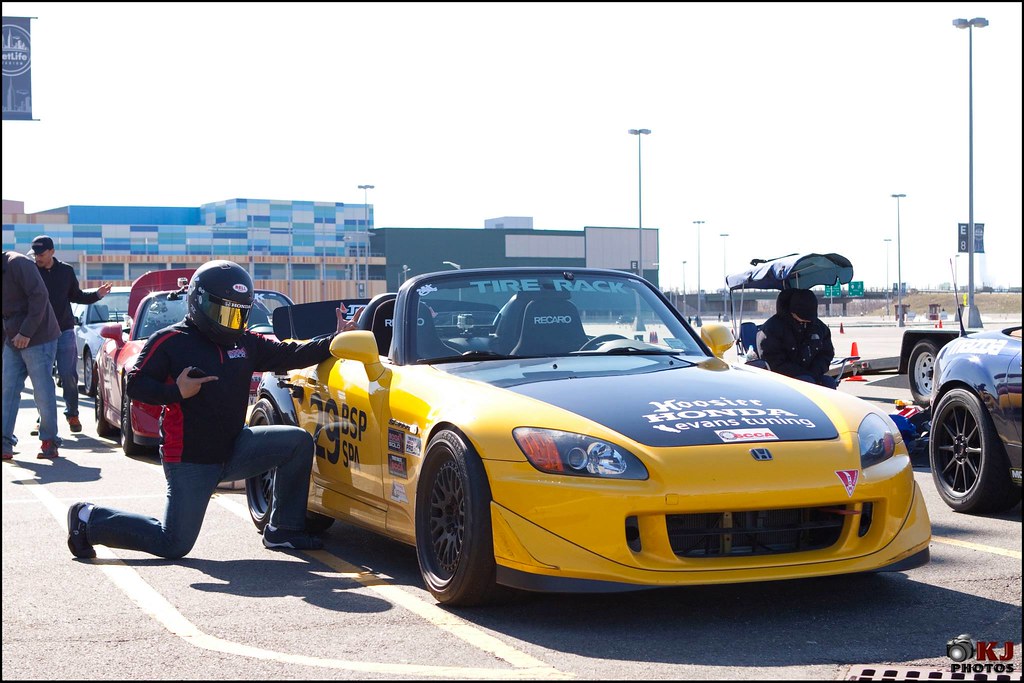 |
| Enjoy your BSP S2000! Try not to giggle like a school girl with all that new found grip and awesomeness. |
What offset wheels are you running
ReplyDelete18x11 front and 18x12 rear with 8.5" backspacing from CCW. I then use spacers up front to push it out. Currently I use 10mm spacers and can achieve full lock without hitting anything.
DeleteIs there any difference in the chassis weight between the AP1 and AP2?
ReplyDeleteIn BSP trim the differences are negligible.
DeleteThanks for the information. I really like the way you express complex topics in lucid way. It really helps me understand it much better way. honda S2000 AP2 F22C engine
ReplyDelete